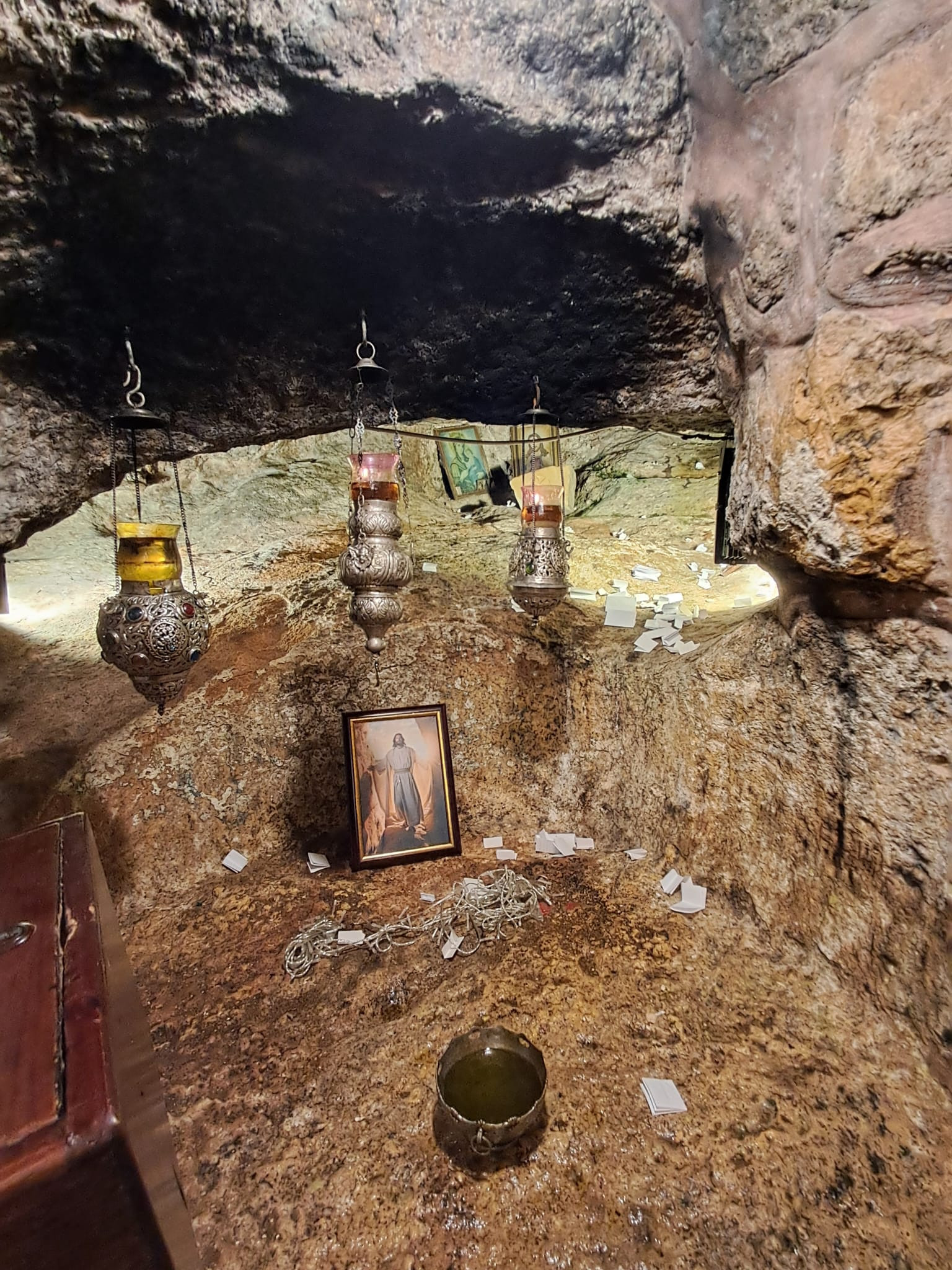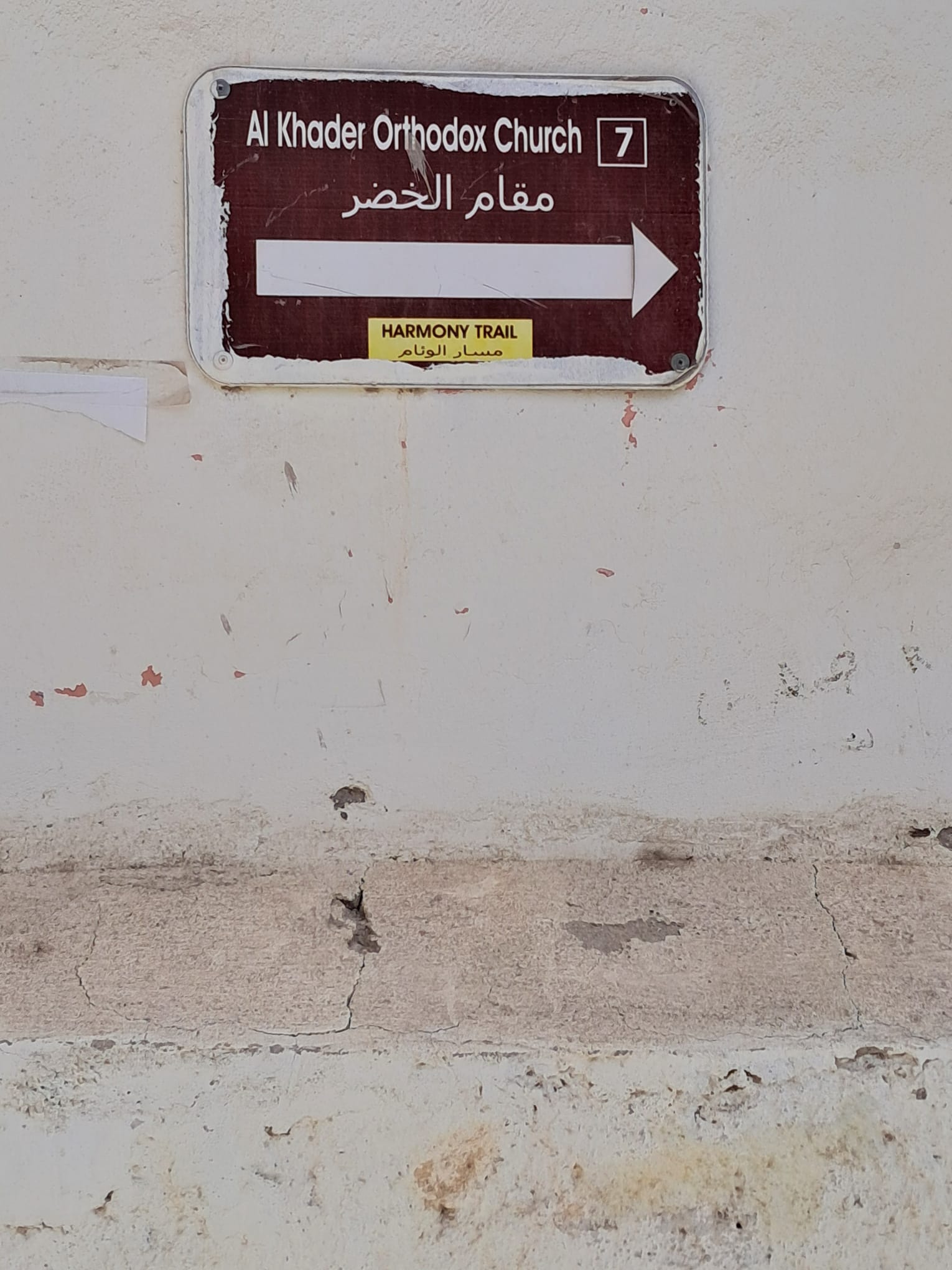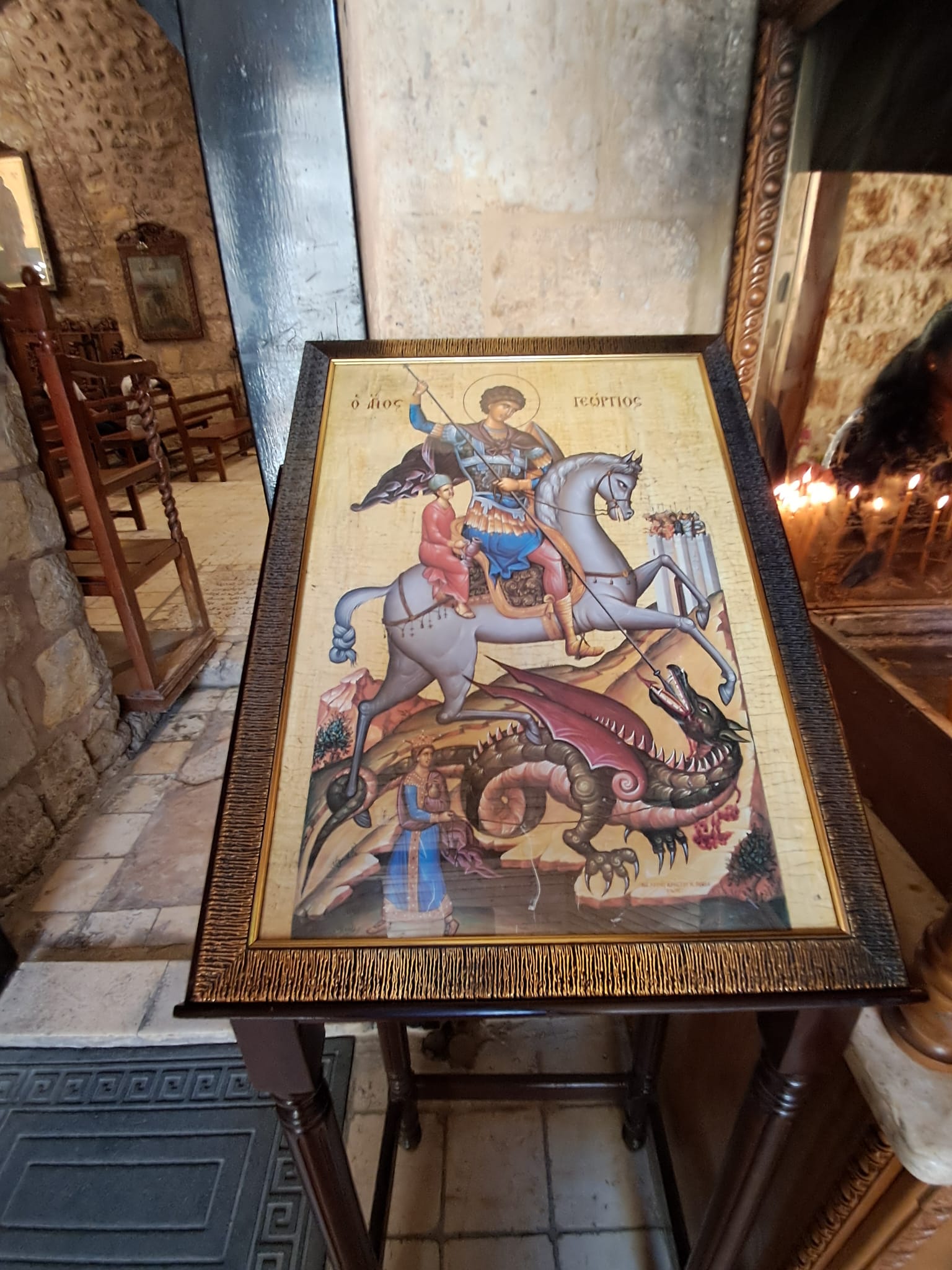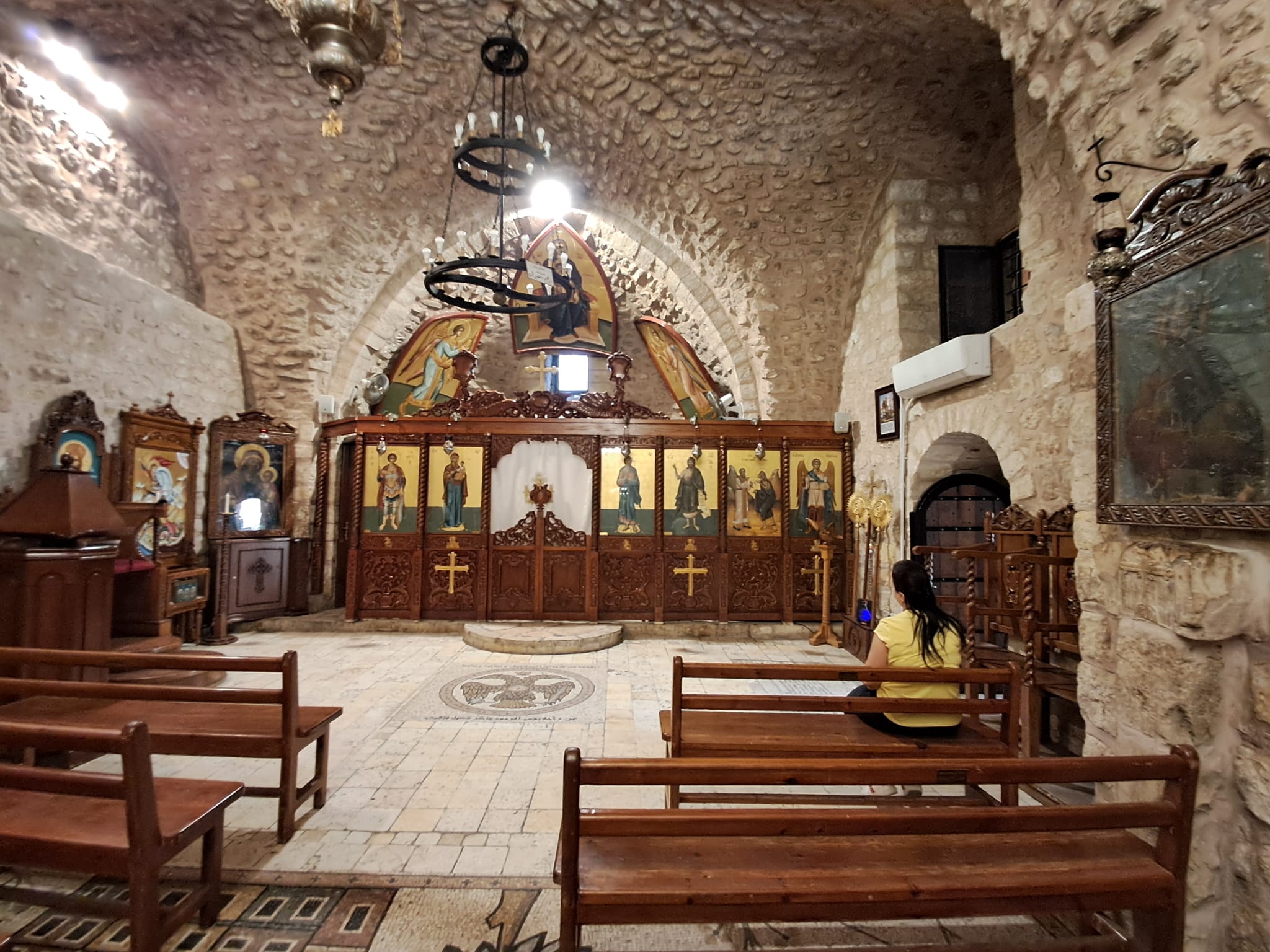
Sarah Islam, 2025
The Church of Saint George in al-Salt as a Co-Produced Religious Site

Located on what local residents refer to as the ‘Harmony Trail’ in the city of al-Salt in Jordan is the three-hundred and fifty-year-old Church of Saint George also known to Christians as al-Khader Church, and known to Muslim visitors as Maqam al-Khidr. Per local legend, on a stormy winter night, a shepherd took his sheep to a cave to seek shelter from the heavy rain. Saint George appeared to the shepherd in the cave as a vision, telling him to convey to the local villagers that they should construct a church at the site, which led to the founding of the church in 1682. Saint George as a religious figure has long been syncretized by many local Muslim and Druze populations with the figure of al-Khidr, a sacred figure in both the Islamic and Druze religious traditions. In combining the narratives of al-Khidr and Saint George, sites in the Levant dedicated to either figure have often turned into multi-religious worship sites venerating both individuals as a composite and co-produced figure. This specific site has long been visited by adherents of all of the aforementioned three religious traditions to seek divine healing, in particular by women struggling with infertility.
In terms of narrative historical placement, Saint George and al-Khidr emerge in different eras and civilizations. Saint George is most often linked to the historical figure George of Lydda, a fourth century Christian martyr venerated as a saint by many Christians. According to legend he was born in Cappadocia to Christian parents, but after his father died he returned with his mother to her family in Lydda, in the Byzantine province of Syria Palaestina. He later joined the Praetorian Guard of the Roman emperor Diocletian. Upon being ordered to recant his Christian faith, he refused and was subsequently arrested and tortured. He was paraded through the streets and thereafter beheaded, being buried near Lydda in April of 303 AD. In some narratives, his death occurs in Nicomedia in the midst of the Diocletian persecution. While the circumstances surrounding his death are disputed, the practice of venerating Saint George as a soldier saint seems to have emerged in the regions surrounding Lydda and dating to at least the fifth century AD, with the active collecting of narratives of his miracles beginning gradually in later medieval times. The legend for which he is most famous—the defeat of a dragon to save a princess—is an eleventh century addition to his hagiographies and not present in earlier collections.
As for al-Khidr, this name is most often associated with an unnamed figure mentioned in the Qurʾan 18:65-82 with whom Moses crosses paths. In the Qur’anic narrative, Moses seeks out his company in order to gain wisdom and insight beyond his own knowledge. While the individual agrees to take Moses on as a companion, he nonetheless warns that Moses himself will not have patience to endure due his limited knowledge and understanding. Moses subsequently witnesses him damaging a sea vessel owned by orphans, killing a youth, and restoring a broken wall in a small village. In each instance, Moses protests his companion’s actions, since they appear to be unjust or in the case of restoring the wall, done without compensation. After the third incident, he explains to Moses that in the case of the boat, had he left it undamaged an unjust king would have confiscated it from the orphaned owners. As for the slain youth, had he lived he would have abused his parents, and he would be replaced by God with a pious and obedient child. As for the wall, it was protecting a treasure belonging to two orphans whose father was pious, from villagers looking to steal their wealth.
Medieval Muslim exegetes identify the aforementioned figure with al-Khidr, even though his name is not mentioned in the Qurʾan. In medieval Sufi tales, al-Khidr also comes to be associated with other traits also not mentioned in the Qurʾanic narrative, including immortality, possessing knowledge of the unseen, and being able to grant fertility. The exegete al-Tabari mentions varying stories referencing al-Khidr. In one narrative mentioned by al-Tabari, al-Khidr is a contemporary of the Prophet Abraham and the Persian king Afridun, living far before the time of Moses. In some versions of this narrative, he is the son of one of Abraham’s followers, and he travels with Abraham after leaving Babylon. Appointed to serve Afridun, who is also equated with the personality Dhu’l-Qarnayn, al-Khidr drinks from a sacred river and becomes immortal. In another narrative, al-Khidr is equated with Elijah or a close companion of Elijah, both of whom meet during an appointed religious holiday every year. In many Sufi narratives, al-Khidr is distinguished as someone who receives insight directly from God without any human intermediary and is still alive in contemporary times. Having received the blessing of long life, medieval Sufi masters including twelfth century Persian mystic ʿAbdul Qadir Gilani, and thirteenth century Andalusian philosopher Ibn ʿArabi state that they have communicated with him whether spiritually or in reality. In Druze theology, al-Khidr is a venerated prophet who possesses the same reincarnated soul as Elijah, Saint George, and John the Baptist and has the ability to heal the sick and infertile.
In terms of the actual site, upon reaching the Harmony Trail in al-Salt, one is faced with a two-part sign, “Maqam al-Khidr/al-Khader Orthodox Church”, pointing towards the complex comprising of a church, the attached cave site, and a mosque at the top of a steep staircase.

The church itself possesses a bell tower and large dome covered on the inside with mosaics and frescoes, and the entrance is flanked with columns. The most artistically noticeable element is the mosaic floor of the church, depicting numerous Biblical scenes including the nativity of Jesus, the resurrection, and last judgment, all in accordance with Byzantine stylistic artistic traditions. A painting of Saint George and the Dragon is also located in the entryway.

The nearby mosque is constructed with sandstone in a modern minimalistic aesthetic. Between the mosque and church, and attached towards the back of the church is the venerated cave site visited by Muslims, Christians, and Druze local populations with an open space to accommodate crowds of worshippers and visitors. While Christian visitors use the pews toward the front of the church for prayers and visit the cave in the back, the church has allocated space for the many Muslims and Druze who come to visit the cave.

According to local records, the cave itself was originally 1 kilometer deep, however it has now eroded to being only several meters deep with mainly its opening area preserved inside of the church. Relics and small venerative objects of various types have been left behind by visitors in the cave, many hoping for healing from illness or infertility.
There is very little publically available historical information or academic research about this specific site beyond what local journalists and religious leaders mention regarding it. This is likely due to its location in a small town, away from larger metropolitan cities. Nonetheless, this site represents a larger trend, namely that religious sites from the medieval era visited by local Christian, Muslim, and Druze populations venerating the composite figure of Saint George and al-Khidr abound in the Levant. More prominent and documented sites include the Dome of Saint George/al-Khidr located at the southwest corner of the Temple Mount in Jerusalem, the Monastery of Saint George in the city of al-Khader in the West Bank, and the Church of Saint George in the city of Lod in Israel.
The composite personality venerated as both Saint George and al-Khidr and ensuing practices linked to his veneration are co-produced phenomena on two levels. First, the figure of Saint George/ al-Khidr is in itself co-produced. The attributes of him having achieved miracles, being the recipient of long life and divine wisdom, and having the spiritual capacity to bestow healing for illness and infertility are all characteristics attributed to him in a contemporary context, but they don’t collectively appear to come from one religious tradition. Rather each of these attributes appears to be derived from narratives about him emerging from different religious traditions all of which interact together in producing one composite personality. His ability to achieve miracles appears to largely align with Christian narratives in reference to his saintly qualities, while his status as someone possessing long life and divine wisdom seems to emerge from medieval Sufi narratives from the Islamic tradition. Him being attributed with the capacity to heal illness and infertility appears to be a dominant theme in early modern Druze narratives but not medieval Muslim or Christian ones.. The development of such a composite figure is paradoxical given that these three religious traditions are often at odds with eachother in terms of religious rhetoric regarding the “Other’. In this capacity, his composite personality as it is venerated now is co-produced.
Second, theological and scholarly argumentation found inreligious texts and among religious scholars often emphasize the boundaries of religious practice, especially norms of worship, vis a vis other religious traditions. In the Islamic tradition for example, worship or veneration inside a church with Christian iconographic paintings and statues would be prohibited. Despite this, cases like this demonstrate that it is not uncommon to find practices in the context of lay lived religion such as the veneration of the co-produced personality of al-Khidr/St. George in communities like al-Salt where multiple religious communities interact and engage with each other across generations. In such cases, it is not uncommon to find adherents absorbing practices or beliefs from outside of their own respective traditions and adopting them as their own, especially when such communities share certain cultural values regarding what impacts one’s future outcomes and opportunities (in this case, good health and fertility). This co-produced practice is further reinforced from the aspect of communal economic benefit; the relevance of Saint George and al-Khidr as a single co-produced personality is what provides sites such as this one the ability to continue to maintain local popularity and relevance and facilitate peaceful co-existence between religious groups. In 2004, a local council in al-Salt consisting of Muslim and Christian community members voted to allocate communal funds to restore and renovate the site to accommodate the continuous stream of visitors, and such cooperation is what has allowed the site to continue its viability as a site for religious tourism. In this capacity, communal economic benefit and co-produced religious practices become intertwined, and both function counter to the expectation that religious groups in these communities would function in full isolation from the eachother.
Further Reading:
Beaurepaire, Pierre-Yves, Katsumi Fukusawa, and Benjamin Kaplan. Religious Interactions in Europe and the Mediterranean World: Coexistence and Dialogue from the 12th to the 20th Centuries. Routledge, 2019.
Ferg, Erica. Geography, Religion, Gods, and Saints in the Eastern Mediterranean. Routledge, 2020.
Meri, Josef. The Cult of Saints among Muslims and Jews in Medieval Syria. Oxford University Press, 2002.
Samain, Rula. “Saint George Reconciles Muslim, Christian Faith in Historic Venue.” The Jordan Times, February 22, 2018. https://jordantimes.com/news/local/st-george-church-reconciles-muslim-christian-faith-historic-venue.
Toorawa, Shawkat. “The Modern Literary (After)lives of al-Khidr.” Journal of Qurʾanic Studies 16, no. 3 (2014): 174-195.
Walter, Christopher. “The Origins of the Cult of Saint George.” Revue des études byzantines 53 (1995): 295-326.
Walter, Christopher. The Warrior Saints in Byzantine Art and Tradition. Ashgate Publishing, 2003.
Wheeler, Brannon. “Moses or Alexander? Early Islamic Exegesis of Qurʾan 18:60-65.” Journal of Near Eastern Studies 57, no. 3 (1998): 191-215.
Wheeler, Brannon. Prophets in the Quran: An Introduction to the Quran and Muslim Exegesis. Continuum, 2002.